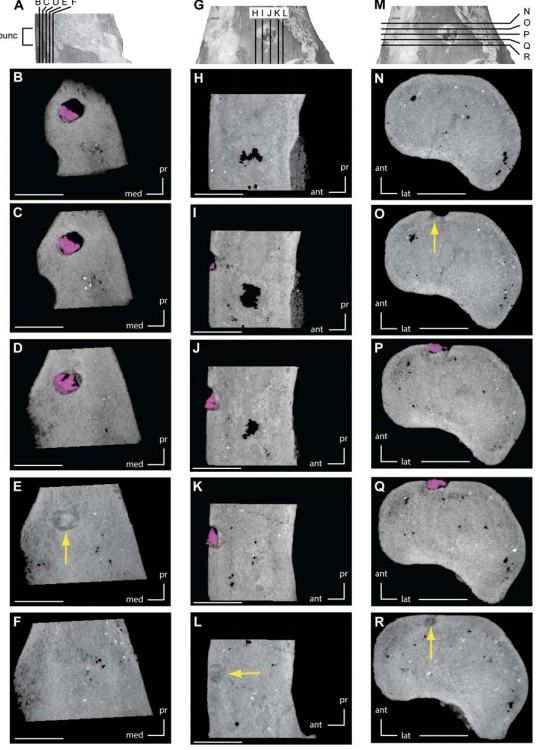Crocs Dined on Young Dinos, Scientists Say

Crocodile-like beasts may have nibbled on young dinosaurs some 75 million years ago, according to scientists who analyzed bite marks on dinosaur bones.
The findings suggest the rivalry between the reptiles started early in life, the researchers say.
Bites from living crocodylians such as alligators and crocodiles are often seen on the bones of their prey and scavenged bodies. Scientists can use these to identify bite marks on fossils from crocodyliforms, the reptiles to which modern crocodylians belong.
Research investigating crocodyliforms from the age of dinosaurs has often focused on the largest such reptiles feeding on equally giant dinosaurs. Now, paleontologists have direct evidence of a small crocodyliform biting juvenile dinosaurs.
Scientists unearthed these fossils in the Grand Staircase-Escalante National Monument in southern Utah.
"This area is very hot and arid in the summer and cold in the winter," said researcher Clint Boyd, a vertebrate paleontologist at the South Dakota School of Mines and Technology. "Most of the area is dominated by massive, cliff-forming rock outcrops."
Back when the reptiles were alive, their environment was warm and wet, dominated by rivers and floodplains and lush with bushes and trees. Dinosaurs in the area included duck-billed hadrosaurs, horned ceratopsians such as Triceratops and predatory relatives of T. rex. The area also holds an especially diverse assembly of crocodyliforms, including the gigantic alligatoroid Deinosuchus riograndensis. [Paleo-Art: Stunning Illustrations of Dinosaurs]
Get the world’s most fascinating discoveries delivered straight to your inbox.
The researchers unearthed 75-million-year-old fossils of at least three members of a kind of small, two-legged herbivorous dinosaur known as a hypsilophodontid. On the right thighbone of one, the researchers found a conical tooth embedded that was just 2.5 millimeters wide (a little less than one-tenth of an inch), and similarly tiny puncture marks were seen on a left shoulder bone.
"I was very surprised to find such clear feeding traces on such small bones," Boyd told LiveScience. "It shows the importance of carefully evaluating all the fossils collected from an area, and not assuming that some fossils won't be important just because they are very small or not completely preserved."
It remains uncertain how large the crocodyliform that made the marks was. However, the dinosaurs in question probably weighed about 28 to 46 pounds (13 to 21 kilograms); and living crocodylians 3 to 6 feet (1 to 1.8 meters) long are known to take down prey that big.
"Usually people tend to focus on the dangers that big, adult dinosaurs were having to deal with, but this study shows that even though dinosaurs were the dominant animals during the Cretaceous, they still had to worry about predators as soon as they were born," Boyd said.
The researchers will continue to study fossils from many time periods to look for additional traces of crocodyliform feeding, such as at an approximately 33-million-year-old locality in Badlands National Park in South Dakota.
Boyd and his colleagues Stephanie Drumheller and Terry Gates detailed their findings online today (Feb. 27) in the journal PLOS ONE.
Follow LiveScience on Twitter @livescience. We're also on Facebook & Google+.




